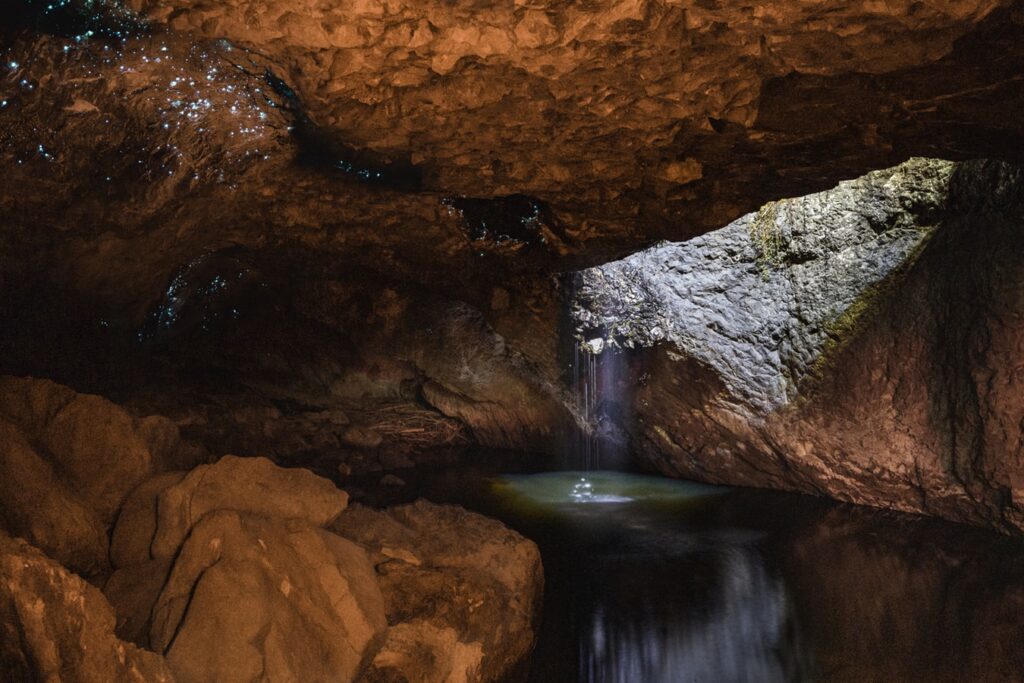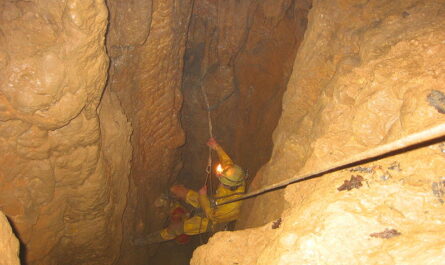Note: As an Amazon Associate I earn from qualifying purchases.
Caving takes explorers out of their comfortable lives and throws them into dark, cold and wet spaces with hard ceilings and floors with no cell phone coverage. It is absolutely essential for cavers to use elementary safety precautions and under no circumstances should safety be ignored or dismissed while exploring caves.

Safe Caving Tips
Common sense: First and foremost – use your common sense. If something looks dangerous, it probably is. If you have to jump and the floor looks slippery, it probably is. If a squeeze seems too tight to pass through, it probably is. Don’t leave your common sense at home – doing so might cost you dearly.
Hard hat: During caving, you literally spend all your time between a rock and a hard place. It is easy to bump your head against the rocky ceiling, especially if you’re passing through a squeeze or crawling due to low ceilings. Cave floors are often wet and it is easy to slip and bump the head on the rocky floor. Under no circumstances should you enter any caves without a solid quality helmet with a chin strap.
Light source: In addition to your primary light source, you should have at least one backup light source – more is better and many suggest bringing three, especially for longer trips. Your headlamp might fail at any point (not just due to dead batteries) and there are few places in the world where it is worse to be stuck in than a cave without a light. Also bring extra batteries for your light sources.
Bring your friends: In caving, the strength is in the numbers (up to a point). Never go spelunking alone, always bring at least another person with you (especially if they are already familiar with this cave). In case something happens to either person, the others can go and call help.
Local caving association: If possible and it exists, get the contact information of a local caving association / cave rescue organization before entering the cave. That way it is possible to contact them in any case of emergency and get help quickly. The people in the association more often than not are familiar with the cave, can navigate in it if there’s a need for rescue and know the coordinates of the cave to help emergency services find the place.
Leave word: Even if you go caving with several people, let your close ones know where you are going and when do you plan to be back. Write down the name of the cave if it has one, its GPS coordinates, the contact info for the local caving rescue organization, and leave this note for them. In a situation where the worst happens and you all get stuck in a cave people at least know where you are and can contact the relevant organization and get help to you.
No jumping: Cross obstacles by methodically climbing over them, not jumping. Never jump over crevices or any openings, instead climb down into the crevice and then up from the other side (only if the crevice is wide enough, not too deep and/or you have received prior training in vertical caving from a qualified instructor). If you can’t cross the opening this way, find a way around it or call it a day – jumping around in caves could end very badly and should not be on your list of things to do.
Know your physical limits: Caving, especially vertical caving, is very demanding for the body and you should be fully aware of your physical limits before entering the cave. If you are not sure of being able to cross the obstacle, don’t risk it. If the vertical climb is potentially too high for you, don’t risk it. Caving is, in essence, just a hobby and no one needs a dead hero. Know your limits.
Basic first aid kit: You should have at least a minimal first aid kit whenever you go caving. It should include bandages for stopping bleeding, cold packs in case of a concussion, and a heat blanket if someone is suffering from a shock or hypothermia. Everything else (band-aids for minor cuts, for example) is an extra you should bring at your own discretion.
Watch your friends: Keep an eye on your friends to see they are doing all right. Some conditions such as shock, concussion, hypothermia, or an underlying medical condition (such as diabetes, for example) can cause confusion and disorientation, so they may not be able to verbally express themselves of something being wrong with them. Watch your friends and seek help if necessary.
Move around: If possible, keep moving around. Hypothermia is a thing and in deep cold caves it is necessary to keep that body temperature up. Usually the physical activity itself is enough to ward off hypothermia but bring a heat blanket just in case. The only case you should not move around is when, somehow, all your light sources fail. It is less dangerous to sit in one place in the dark than risk getting injuries moving around. In this case, sit tight (do push ups if it gets cold) and wait for help.
Food and water: Bring both and more than you think you need. If you happen to get stuck you will be thankful that you have them. High energy bars that have nuts, honey, cocoa butter, oats etc. in them are awesome because they have great nutritional value yet weigh very little.
No vertical caving unless you’ve received training: Don’t go crazy climbing up walls or into deep crevices if you have not done any ropework under the supervision of a qualified specialist. Vertical caving is a specialized skill and inexperienced climbing can result in injuries or death.
Fully charge your phone and take it with you: Even though there is no cell service in a deep cave it is important to take a fully charged phone with you anyway as if something happens it is possible to exit the cave quickly and call for help as soon as you’re outside.
Conclusion
Use your common sense while caving and follow the caving tips previously mentioned. Caving is fun but it can also be dangerous and you should prepare yourself for the worst. The above include the most essential safety tips but there are more, such as wearing gloves and knee pads, for example, that help you against injuries. If you have more caving safety tips, let us know in the comments!



Recommend taking a minimum of four, so that way if one person gets hurt, a second person can stay with them while the other two leave together to go get help.